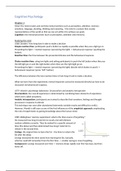Samenvatting
Summary Cognitive Psychology chapter 1 - 7, exam 1
- Vak
- Instelling
- Boek
Detailed and to the point summary of the first 7 chapters of Cognitive Psychology. Includes all bolded words and important concepts. Includes pictures. 32 pages long. Taken from the book Cognitive Psychology by van Hooff and Goldstein
[Meer zien]













